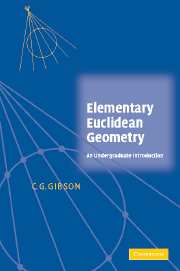Book contents
- Frontmatter
- Contents
- List of Figures
- List of Tables
- Preface
- Acknowledgements
- 1 Points and Lines
- 2 The Euclidean Plane
- 3 Circles
- 4 General Conics
- 5 Centres of General Conics
- 6 Degenerate Conics
- 7 Axes and Asymptotes
- 8 Focus and Directrix
- 9 Tangents and Normals
- 10 The Parabola
- 11 The Ellipse
- 12 The Hyperbola
- 13 Pole and Polar
- 14 Congruences
- 15 Classifying Conics
- 16 Distinguishing Conics
- 17 Uniqueness and Invariance
- Index
14 - Congruences
Published online by Cambridge University Press: 06 July 2010
- Frontmatter
- Contents
- List of Figures
- List of Tables
- Preface
- Acknowledgements
- 1 Points and Lines
- 2 The Euclidean Plane
- 3 Circles
- 4 General Conics
- 5 Centres of General Conics
- 6 Degenerate Conics
- 7 Axes and Asymptotes
- 8 Focus and Directrix
- 9 Tangents and Normals
- 10 The Parabola
- 11 The Ellipse
- 12 The Hyperbola
- 13 Pole and Polar
- 14 Congruences
- 15 Classifying Conics
- 16 Distinguishing Conics
- 17 Uniqueness and Invariance
- Index
Summary
An interesting facet of human psychology is that we perceive differences between objects more readily than we do similarities. For instance, looking at the illustrations of standard conics in Chapter 4 you probably feel there are clear differences between an ellipse and a hyperbola, but may be less sure about the similarities between two parabolas. In mathematics we can only assert that two objects are ‘different’ when we are perfectly clear about what we mean by them being ‘the same’. Formalising this idea is the immediate problem facing us. One of the sublimal messages of geometry is that there is no one answer, it all depends on your objectives. People who take a ‘black or white’ view of the world may find this unsettling, whereas those who relish the gamut of intermediate greys will sense interesting possibilities.
We adopt the approach of greatest relevance in the physical sciences. In a nutshell, the idea is to think of two conics as being ‘the same’ when the one can be superimposed on the other. That is an eminently practical criterion. Suppose for instance that you have two ellipses drawn on a flat surface. Each ellipse could be traced on to a plastic transparency with a felt tip pen. Mark the centres of the ellipses. We could proceed in two steps. First we could slide one transparency across the surface till the centres of the two ellipses coincide: then we could rotate the transparency about the common centre to see if they superimpose.
Information
- Type
- Chapter
- Information
- Elementary Euclidean GeometryAn Introduction, pp. 137 - 148Publisher: Cambridge University PressPrint publication year: 2004
